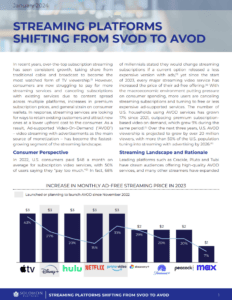 Streaming Platforms Shifting From SVOD to AVOD
Streaming Platforms Shifting From SVOD to AVOD
In recent years, over-the-top subscription streaming has seen consistent growth, taking share from traditional cable and broadcast to become the most watched form of TV viewership.(1) However, consumers are now struggling to pay for more streaming services and canceling subscriptions with existing services due to content spread across multiple platforms, increases in premium subscription prices, and general strain on consumer wallets. In response, streaming services are looking for ways to retain existing customers and attract new ones at a lower upfront cost to the consumer. As a result, Ad-supported Video-On-Demand (“AVOD”) – video streaming with advertisements as the main source of monetization – has become the fastest-growing segment of the streaming landscape.
Consumer Perspective
In 2022, U.S. consumers paid $48 a month on average for subscription video services, with 50% of users saying they “pay too much.”(2) In fact, 68% of millennials stated they would change streaming subscriptions if a current option released a less expensive version with ads,(3) yet since the start of 2023, every major streaming video service has increased the price of their ad-free offering.(4) With the macroeconomic environment putting pressure on consumer spending, more users are canceling streaming subscriptions and turning to free or less expensive ad-supported services. The number of U.S. households using AVOD services has grown 17% since 2021, outpacing premium subscription-based video on demand, which grew 9% during the same period.(5) Over the next three years, U.S. AVOD viewership is projected to grow by over 20 million viewers, with more than 50% of the U.S. population tuning into streaming with advertising by 2026.(6)
Streaming Landscape and Rationale
Leading platforms such as Crackle, Pluto and Tubi have drawn audiences offering high-quality AVOD services, and many other streamers have expanded their subscription offerings to include an AVOD tier in response to the above trends. In the last year, Disney+ and Netflix both introduced AVOD services; 50% of new Disney+ subscribers have opted for the AVOD plan(7) while Netflix’s ad-supported tier has reached over 15 million active users.(8)
By offering an AVOD service, streaming platforms provide an entry-level option to new users and a low-cost alternative for existing users who contemplate canceling their subscriptions. Ad-supported services also generate additional revenue streams for streaming platforms, and advertisers value the ability to show advertisements to a captive audience on a large-screen TV.(9) These plans can be even more profitable per customer than the existing subscription plans — in 2019, Hulu’s AVOD service generated more revenue per subscriber than its premium, ad-free version.(10) More streaming platforms are expected to introduce AVOD platforms, with Amazon Prime Video already announcing plans to launch an AVOD service in 2024. By 2025, the U.S. AVOD market is expected to overtake the traditional TV market, and by 2030, most online video service subscriptions will be partially or wholly ad-funded.(11)
Click below to read the article from the Global Media Group.
1. Nielsen Insights; 2. Deloitte; 3. Samba TV; 4. Variety; 5. Comscore; 6. eMarketer, Insider Intelligence; 7. Disney; 8. Bloomberg; 9. MediaScience; 10. New York Times; 11. Deloitte.
Read the Article


